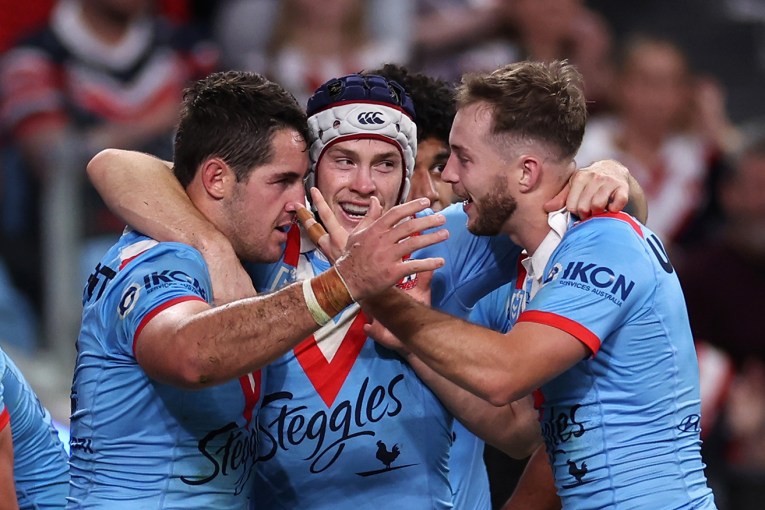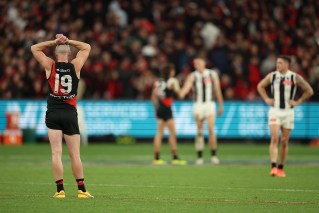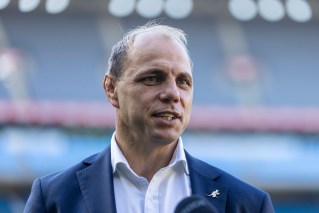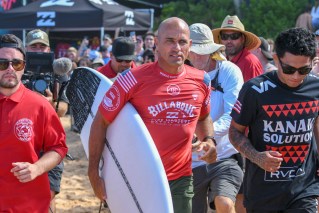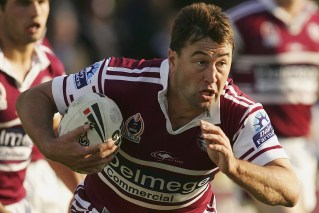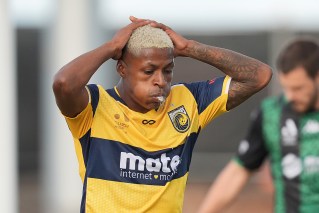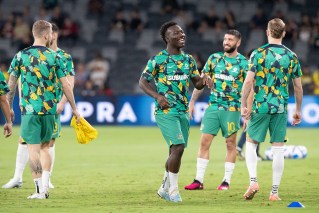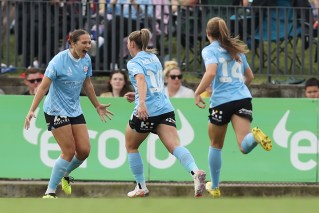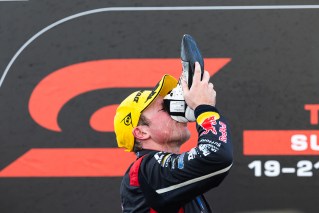Some distance from reality: NRL tackled on bid to end sport’s slumber

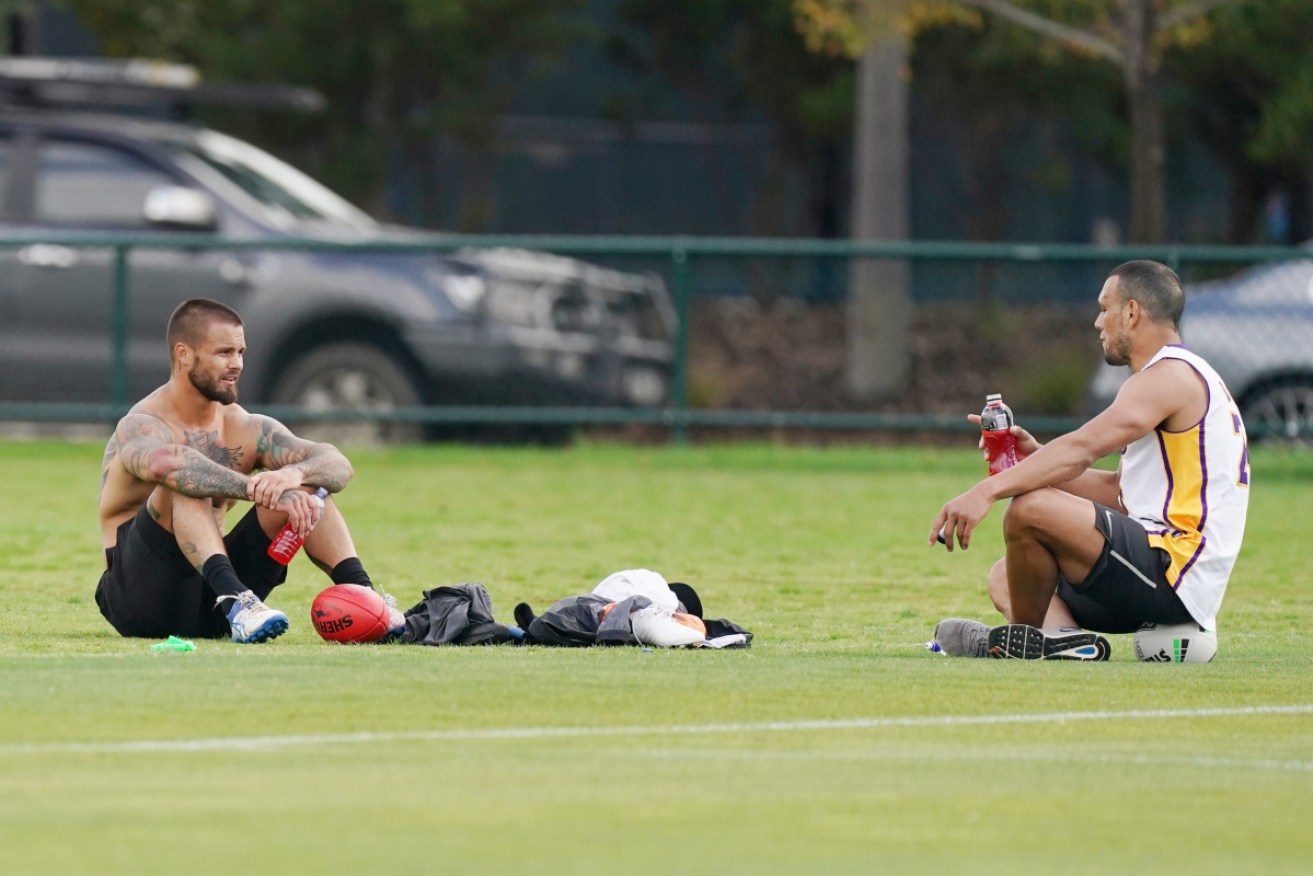
At a distance: Melbourne Storm player Sandor Earl and former teammate Will Chambers training in Melbourne. Photo: AAP
If it is true that sport is about community, what should we make about the haste with which some sporting administrators are urging a return to the field?
The federal Sports Minister Richard Colbeck made his feelings known on Monday, telling ABC’s Radio National that codes like the NRL need to be “cautious” when dealing with people’s health.
There’s little doubt the fans are missing sport, but as most Australians worry about work and home arrangements there’s yet to be any urgent collective demand for sport to return.
And just as some competition officials were reluctant – even recalcitrant – in closing down their matches to fight the pandemic the same names are pushing hard for a restart.
The reason? Cash.
Or, more particularly, television broadcast rights – the lucrative lifeblood that has kept sport in the green for several decades.
But this pandemic is not something that sports administrators can just will away, or – like the proverbial au pair visa – be just a phone call away from a fix.
In Australia, the competition copping the most stick through the crisis has been the NRL, which was one of the last to suspend its season and is now seeking to be the first to re-open it – even proposing a firm restart date of May 28.
Despite seemingly being ticked off by NSW Police, it’s a plan that has got short shrift from Queensland Premier Annastacia Palaszczuk.
She has made it clear the state’s three clubs would not be permitted to travel back and forth to Sydney to play games under current quarantine restrictions.
Tweet from @JamColley
“I would love to see the footy back. I would love it just like anyone else,” Palaszczuk said.
“But we have to have the clear health advice, and there is no clear health advice at the moment that is telling me the NRL can start and no other sport can.”
Mr Colbeck also labelled the NRL plans “a bit ambitious, to be frank”.
“If you consider the advice that we are still getting from people like [chief medical officer] Brendan Murphy … they’re the people who I think should be providing advice on these things.
“I think we need to be really cautious about the circumstances we are in.”
In the parlance of the game, the NRL’s leadership is having “a shocker”.
The initial coronavirus outbreak saw head office all but begging the federal government for a multimillion-dollar bail, which was quickly followed by an unseemly spat with its host free-to-air broadcaster Channel Nine.
“Nine has invested hundreds of millions in this game over decades and we now find they have profoundly wasted those funds with very little to fall back on to support the clubs, the players and supporters,” Nine noted in a statement referencing the NRL’s lack of a ‘rainy day’ fund.

NRL CEO Todd Greenberg and ARLC chairman Peter V’landys are working on how to restart the competition. Photo: AAP
“It would now appear that much of that has been squandered by a bloated head office completely ignoring the needs of the clubs, players and supporters.”
ARL Commission chairman Peter V’landys has this past week been working furiously to repair that damage by supercharging his plan to restart the season and give Channel Nine the content it craves.
Tweet from @TitusOReily
V’landys even started offering the sort of rosy comments on medical issues that would make US president Donald Trump blush, noting in an interview with NRL.com.au that COVD19 infection rates had dropped from 22.27 per cent when the league shut down to a current figure of 1.34 per cent.
“There’s a lot of work to be done between now and that date, however we are very confident we will get there,” he told NRL.com.au.
Hopefully in another seven weeks that’s going to be substantially lower than that. The risk is minimal.
“… By the 28th of May that will happen. The infection rate is continuing to come down.”
Asked about the rush to return, V’landys told NRL.com.au: “People are entitled to their view but I have to act in the best interests of the game.”
Note: In a global pandemic, medical professionals and governments may just have a better idea of how to proceed than any one sporting official looking at the financial bottom line.
Various plans have been floated for how rugby league could return by late May, including a fly-in, fly out island to house players and holding matches at regional hubs in warmer climates.
And while NRL clubs bleed cash through no crowds, no TV and closed poker machine venues, the situation in the AFL is no less urgent.

The empty MCG during the first round of AFL matches. Photo: AAP
Based mostly in Victoria where Premier Daniel Andrews has been a leader in strong lockdown laws to fight the COVID-19 outbreak, the AFL has had little choice but to toe the line and ponder ways it could finish its proposed 17-round season.
The AFL has also been looking at a plan to create regional hubs for the restart of its season, with more details expected by the end of this month.
Clearly, the AFL learned its lesson in its opening round of the season, which, in truth, was a bit of a fizzer.
It immediately aborted the season after all games were played.
Chief executive Gillon McLachlan has hardly put a foot wrong since, tidying up after Collingwood president Eddie McGuire on the issue of members refunds for fans, and hastening slowly on any talk of rebooting the season.
With social distancing measures still in place for months to come it remains a poor example to televise any contact sports, which could increase the likelihood of fans mingling at home or elsewhere to watch the broadcast.
Often touted as role models, this is an actual real-life opportunity for sport stars to be one.
Expect then the AFL to wait for the financially desperate NRL to do the legwork before dipping its toe back in the water.
Tweet from @PAFC
There are some sports rolling on through the crisis, with thoroughbred racing in particular cited as an example.
All events are now being held without crowds and racing’s usual adherence to strict quarantine requirements also gives it a pass when assessing the risks.
It also clearly doesn’t hurt to have the wagering industry onside.
Sport still remains shut down in most parts of the world, although baseball and soccer has resumed in Taiwan this week, after that nation’s success in reducing infection rates.
-with AAP
